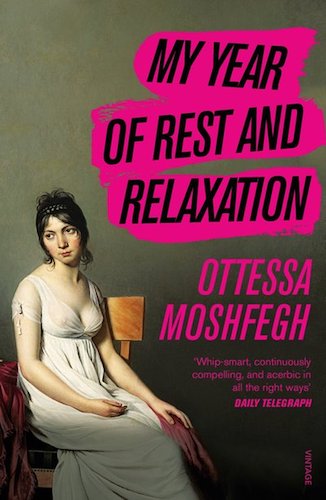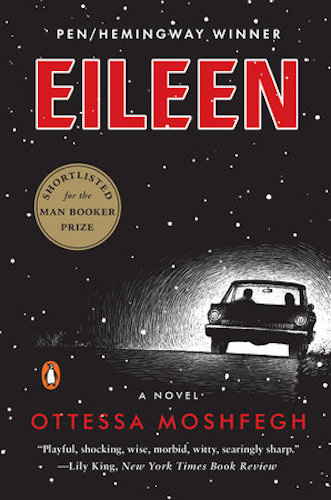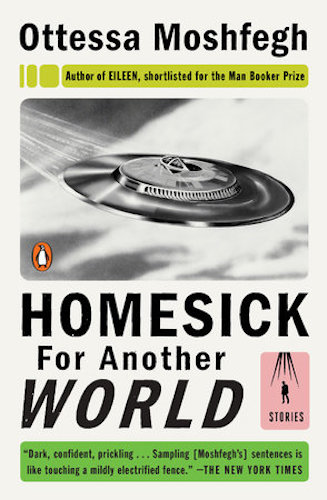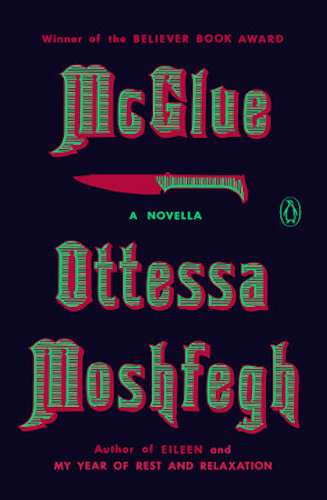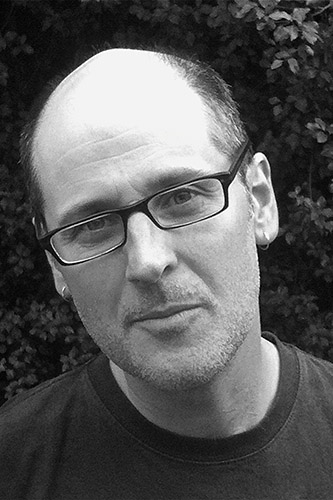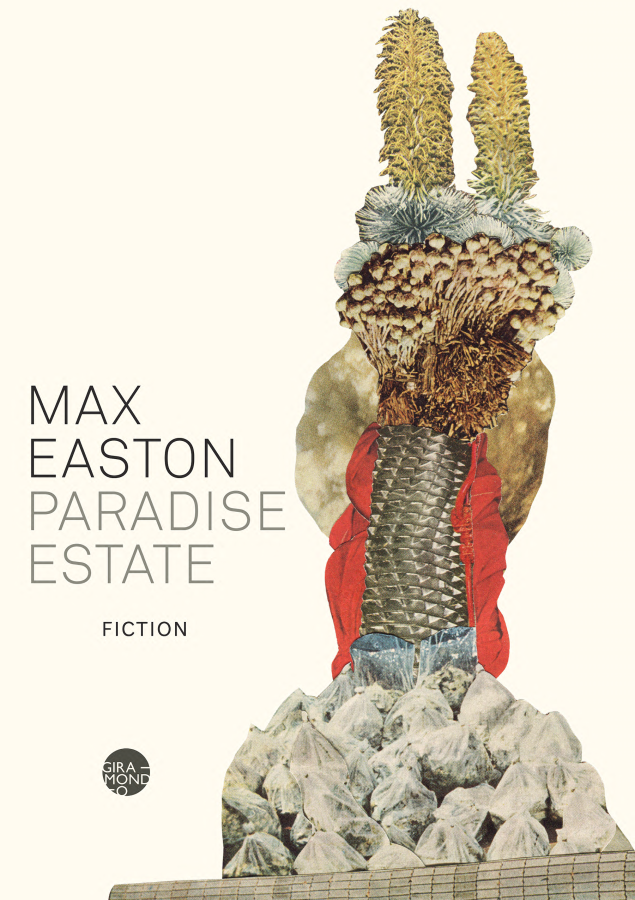Ottessa Moshfegh’s protagonists are, as a rule, unimpressed — with society, with their families and acquaintances, with life in general. ‘I hated almost everything,’ declares the narrator of Eileen; ‘I was unhappy and angry all the time.’ Her dissatisfaction is shared by the unnamed narrator of My Year of Rest and Relaxation, who feels like ‘a baby being born — the air hurt, the light hurt, the details of the world seemed garish and hostile … the constant barrage made it hard not to hate everyone and everything.’ In one of the fourteen short stories collected in Homesick for Another World, the central character observes that people are ‘so dishonest with their clothes and their personalities’. In another, a teacher complains that all she ever does is ‘contend with stupidity and ignorance’. A third story is narrated by someone who thinks the ‘entire world is stupid’. A fourth features a man who admits to having ‘a thing about fat people. It was the same thing I had about skinny people: I hated their guts.’
Moshfegh is well aware that there is something a little jejune about this kind of sweeping contempt. The narrators of Eileen and My Year of Rest and Relaxation have a knowing air that is at times reminiscent of that archetypal world-weary adolescent Holden Caulfield, even though both of them are in their mid-twenties. Their caustic observations perform the same seductive trick: they draw you into an intimate alliance against the hypocrisy, absurdity and ugliness they see around them. There is a special satisfaction in being invited to share the exquisite isolation and ennui that result when you are the only person smart enough to have realised that people are idiots and everything is a sham.
What makes Moshfegh an uncommon writer is that beneath the scorn and the dark humour there lurks an authentic Swiftian disgust. Her work has a corporeal, rebarbative, scatological quality. She revels in the grubbiness of the human body, splashes the ordure around like a preschooler in a muddy puddle. Her characters smell bad. And this recurring note of fascinated distaste makes it hard to disentangle their misanthropy from their self-loathing. For Moshfegh, negative emotions always possess this double-edged quality. Her characters recoil from a hateful reality, but they have also internalised its hatefulness. They are uncomfortable with their own embodiment; they neglect their physical wellbeing (even maintaining minimal standards of personal hygiene would seem to be too much of a concession to the world’s phoniness); they cultivate self-destructive habits and seek solace in oblivion.
These themes are established in Moshfegh’s scabrous first novel McGlue, which is set in 1851 and told from the shattered perspective of an alcoholic sailor. McGlue has been accused of murdering his only friend Johnson, but has no recollection of doing so. The novel opens with him locked in the reeking hold of a ship that is returning him to his home town of Salem to be tried. As he travels toward this reckoning, he attempts to reconstruct events with what’s left of his ruined mind. The drinking that has punched black holes in his memory and scrambled his sense of chronology — and which makes him smell like ‘a dead horse’s ass’ — is motivated by a desire to obliterate his wretched past. By the time he was in his early twenties, he thinks bitterly, he was already so ‘hammered down’ that he knew he was ‘doomed’. But the novel does not overly trouble itself with the psychology of trauma or addiction. It is a work of jagged expressionism, all rancid atmosphere and grisly imagery. McGlue projects an inchoate and indiscriminate revulsion; his repudiations are impulsive, excessive, grotesque. Early in the novel, he remembers landing in New York with Johnson, who gushes ‘this is where the money is and this is where I want to make it … you’ll make it with me, right?’ McGlue does not want to make it:
I wanted to lie down with it and strangle it and kill it and save it and nurse it and kill it again and I wanted to go and forget where I was going and I wanted to drink and get my head ruined but I certainly hadn’t thought about making it.
The significance Moshfegh grants to this kind of violent and conflicted negation cannot be considered without taking into account the highly suggestive fact that her three novels to date are essentially variations of the same book. Though they have quite different settings and cultural reference points, they have a number of structural elements in common. More importantly, they share a mythos.
Each is written in the first-person from the point of view of a character who feels trapped in an intolerable existence, who experiences life as a form of living death. The eponymous Eileen Dunlop, who faces the world with a blank expression she calls her ‘death mask’, can be taken to speak for all of them when she declares that she does not believe in heaven, but she does believe in hell. And she believes she is in it. ‘People act like everything’s OK all the time,’ she rages. ‘But it isn’t. Nothing is OK at all … We’re in hell, aren’t we?’
Each novel dramatises a battle for the integrity of the narrator’s besieged conscience. In McGlue, this is symbolised by the violence directed against McGlue’s head: he cracks his skull falling from a train; when he is denied alcohol, he takes to bashing his head against the wall. The notoriety of his home town reinforces the idea that this violence is a physical manifestation of his sense of metaphysical alienation. As his lawyer points out, the citizens of Salem ‘don’t have a soft record when it comes to convicting people of evildoing’. The accusation of being a witch or a devil, he goes on to observe, was usually levelled against anyone ‘the least but own-minded’, anyone who had ‘what’s called a personality — a difference of opinion’. In a subtle ironic reversal, McGlue subsequently envisions the parishioners of Salem as ‘witches’ who want to poke holes in his skull to extract the evil within. His disturbed sense that his mind may indeed be a source of evil prompts him, near the end of the book, to perform his own improvised trepanation: he tries to gouge out his brain with a shard of broken mirror. ‘Maybe I am mad,’ he thinks. ‘My mother thinks I am the son of the Devil. How could she be wrong?’
The novels imply that this angst is a form of twisted egotism. Moshfegh’s protagonists want to escape the hell of other people; they are at war with reality and at war with themselves. But their ostracism has its willful, self-perpetuating aspect. There is a Dostoevskian quality to their psychology. They are entrapped by their own negations, their need to assert their independence of mind, which only serves to make thinking itself a form of torment. They cultivate their singularity by going out of their way to be unattractive and anti-social. ‘It always peeved me when my flatness was met with good cheer,’ Eileen complains of an affable colleague. ‘Didn’t she know I was a monster and a crone? How dare she mock me with courtesy when I deserved to be greeted with disgust and dismay?’
Eileen sets herself apart, preferring to ‘sit and rage quietly’. She recycles a grimly ironic line from McGlue when she notes that her own father regards her as the Devil’s spawn. Like McGlue, she self-medicates, numbing her mind with copious quantities of alcohol. She fantasises about physically unravelling the knots in her brain, or perhaps curing her perpetual unhappiness once and for all with a lobotomy, and she again evokes McGlue when she scorns the idea that psychologists might have something to say about her predicament: in another era, she scoffs, the people in that disreputable profession would ‘all be burned as witches’. The inevitable end point of her comprehensive negation is the perfect isolation of solipsism: ‘Why should my heart ache for anyone but myself? … I was the only one whose pain was real.’
The premise of My Year of Rest and Relaxation takes this insularity to even greater extremes. The novel describes the narrator’s attempt to blot out the world entirely. She holes up in her apartment and sedates herself with a cocktail of prescription narcotics sourced from her pliable psychiatrist, Dr Tuttle. She enters into her extended period of ‘hibernation’ with the aim of demoting reality to the status of unreality, making its hard edges seem soft and inconsequential, reducing the entire world to the manageable scale demanded by her hypersensitive consciousness: ‘This was the beauty of sleep — reality detached itself and appeared in my mind as casually as a movie or a dream. It was easy to ignore things that didn’t concern me.’
The inability of Moshfegh’s protagonists to reconcile themselves to their realities is given dramatic form in their ambivalent personal relationships. All three narrators are the products of dysfunctional families; they are all orphaned or estranged from their parents. But they are not completely isolated, despite their best efforts. Each is granted a friend, who is the only person capable of disturbing their defensive solipsism — McGlue has Johnson; Eileen is drawn into the orbit of a glamorous co-worker named Rebecca; the somnolent narrator of My Year of Rest and Relaxation is attended by her loyal but needy friend Reva. These companions act as psychological foils. They are loved and hated, appreciated and resented. They allow Moshfegh to satirise her protagonists’ insularity by appearing at different times as reflections and symbolic antitheses. In a more or less open acknowledgement of the similarity of their roles, Moshfegh has even given Rebecca and Reva the same name: the former is the anglicised version of the Hebrew name Rivka, from which Reva is also derived.
Perhaps the most striking parallel is the fact that each of Moshfegh’s novels culminates in a moment of release or escape that involves the destruction of its central friendship. In McGlue, this takes the form of a literal slaying of McGlue’s symbolic other, a moment rendered as a morally ambiguous act of selflessness, a fleeting but harmonious fusion of love and death. In Eileen and My Year of Rest and Relaxation, the narrators leave their old relationships and their old selves behind in a straightforward sense, and their personal transformations are given added symbolic weight by coinciding with dates laden with significance: Eileen takes place in a small New England town in the week leading up to Christmas; My Year of Rest and Relaxation is set in New York in the period immediately prior to the terrorist attacks of September 11, 2001.
Moshfegh has become increasingly adept at honing her characters’ incorrigible self-involvement and generalised sense of disgust into effective satirical weapons. This aspect of her work is murkily present in the disjointed and historically distant McGlue, and it is deployed in a somewhat inconsistent fashion in the stories in Homesick for Another World, but it comes sharply and brilliantly into focus in Eileen and My Year of Rest and Relaxation, which fuse their narrators’ churning feelings of rage and disequilibrium to the experience of being a young woman. It is not incidental that the names Rebecca and Reva mean ‘ensnarer’ — an allusion to the biblical Rebecca’s captivating beauty. For Moshfegh, it is not besotted male lovers who are ensnared by femininity, but women themselves. Her female protagonists are oppressed by the world’s corruptions and superficialities, but they are also trapped by expectations and assumptions, which render them incapable of self-determination and leave them suspended in states of emotional immaturity.
Eileen is a shrewdly conceived thriller that is wry enough about its generic affiliations to qualify as a rarefied parody. It is smartly plotted (the gun mentioned in the first act is fired in the last) and it contains a number of echoes of Daphne du Maurier’s Rebecca, from which it takes the central idea that Eileen is a surrogate figure, someone who has unwittingly stepped into the shoes of a dead woman, her creepy situation symbolised by the fact that she literally wears the deceased’s clothes. Eileen’s unhappy fate is to have replaced her mother. She takes care of her widowed father — an ex-cop and hopeless alcoholic — while holding down a dull administrative job at the local juvenile prison. Reflecting on the miserable existence she has inherited, Eileen observes that the life of a woman ‘seemed utterly detestable to me. There was nothing I wanted less back then than to be somebody’s mother, somebody’s wife. Of course, I’d already become just that for my father at the tender age of twenty-four.’
The novel is laced with portentous Freudian motifs. It is replete with intimations of incest and frankly expressed parricidal impulses; it suggests that sex and violence are fatally entwined, that the apparent orderliness of society is a facade concealing the realities of perversion and death. ‘It’s easy to tell the dirtiest minds,’ Eileen aphorises — ‘look for the cleanest fingernails.’ The novel’s symbolism makes plain the connection between her onerous circumstances, her sense of social alienation and anger, her sexualisation, and her powerful feelings of shame and disgust. Phallic icicles hang in menacing Damoclean fashion above her front door. She is repelled by mouths. She voids her bowels irregularly and violently, with the aid of handfuls of laxatives, and she is able to do so only in the basement, a room she associates with her mother’s dark secrets. She suffers from ‘that unfortunate maladjustment to puberty — still at twenty-four — that made me ashamed of my womanliness’, and she horrifies herself by examining her body in the mirror:
I took off my sweater, blouse and brassiere and took an earnest look at my bust, assessing the heft and shape of my little breasts … When I menstruated, by breasts were sore to the touch and heavy, like lead, like rocks. I pinched and poked them with my fingers. I took off my pants, but didn’t look at myself below the waist … there was something so foreboding and gross about those hips, the buttocks, the thighs. And there was always a sense that those parts would suck me into another world if I studied them too closely. I simply couldn’t navigate that territory. And at the time, I didn’t believe my body was really mine to navigate. I figured that was what men were for.
None of this requires much in the way of decoding. Eileen’s narration establishes a reflective distance that allows her to diagnose to own conflicted state. The novel is set in 1964, which pushes the action just far back enough in time to predate the sexual revolution and give the assumed gender roles a solidly conventional cast, but Eileen is remembering events many years later, with all the wisdom of hindsight and maturity. This divided narration, which places us at once inside and outside the young Eileen’s perspective, gives an ironic inflection to her outsized angst and the calculated transparency of the symbolism. And it is used to suggest that the sources of her unhappiness are not necessarily all that mysterious. ‘One doesn’t need a college degree,’ she deadpans — an idea reiterated by Rebecca at a crucial point later in the novel.
Eileen and My Year of Rest and Relaxation are concerned with the cultural impositions that encourage their protagonists’ conspicuous maladjustments. The two novels approach this question in slightly different ways, but both suggest that a fixation with appearances is one of the principal factors holding the young women in their immature states, causing them to redirect their violent sentiments against their own bodies. They are, to borrow a phrase from Angela Carter, caught between flesh and the mirror. Their physical disorders are depicted as manifestations of their crises of identity, which are in turn the products of their discomfort with the social roles they are expected to play, their objection to being prejudged, their inability to claim ownership of their still unformed selves.
‘I was obsessed with the way I looked,’ Eileen states at the outset — only to claim subsequently that her desire is, in fact, to pass completely unnoticed. She is small and mousey in appearance, and feels herself to be inconsequential. She dresses in her dead mother’s clothes as a ‘costume’, so that ‘nobody would really see me’. Rebecca appears as Eileen’s spectacular opposite: she is gorgeous, stylish, well groomed, the focus of attention in any room she enters. She claims to be Harvard educated and has the confident air and polished manners to make the story credible. Yet both women are unavoidably implicated in the hypocrisy Eileen deplores: their cultivated externalities replicate the sinister divide between false appearances and hidden truths that pervades the novel. Neither is really herself, because neither is capable of being herself.
The relationship between Reva and the narrator of My Year of Rest and Relaxation is similarly presented as a study in contrasts. The narrator would seem to have everything going for her. She is a blonde, independently wealthy, conventionally beautiful WASP. Reva, on the other hand, is dark haired and Jewish and comes from a relatively humble background. In this novel, it is Reva who numbs herself with alcohol and carries the greatest burden of bodily shame: she is a bulimic who believes she is fat and unattractive, even though it is suggested that this is not really the case. The narrator’s attitude toward her own appearance is closer to indifference, though her beauty means she has her cross to bear. ‘Being pretty,’ she laments, ‘only kept me trapped in a world that valued looks above all else.’
Much of the barbed cultural commentary that runs through My Year of Rest and Relaxation is organised around the contrasting attitudes of Reva and the narrator. Reva wants nothing more than to conform. She wants to be fashionable; she wants a husband and a career. She has internalised the beauty myths and the shallow consumerist desires that society has imposed. This makes her permanently miserable. The narrators scoffs at her for being a ‘slave to vanity and status’.
The novel’s central irony is that the narrator, in rejecting Reva’s worldly aspirations as so much contemptible phooey, indulges in her own form of vanity, which infantilises her without transcending the superficial culture she affects to despise. In her own way, she too represents regressive aspects of that culture. She is a selfish brat who is seeminglt devoid of empathy, or even sympathy (Moshfegh has referred to her in an interview as an ‘asshole’). Her grand plan to sedate herself seeks a medicated solution to what is essentially a metaphysical problem. Her ambition is to ‘become a whole new person … sleep myself into a new life … a new spirity’. She claims to be pursuing a ‘paradise of realised dreams’. But she doesn’t really know what those dreams are. When she looks inside herself she finds that there’s no there there. She is as hollow as the culture she loathes.
Dr Tuttle — a memorable comic creation, who is exalted at one point as ‘a pharmaceutical shaman, a magus, a sorcerer, a sage’ — merely enables the self-indulgence, proffering dubious justifications for her patient’s unfortunate condition. ‘The modern age,’ she explains, ‘has forced us to live unnatural lives.’ When the narrator confesses that she has been philosophising, or maybe just thinking too much, Dr Tuttle is immediately concerned: ‘That’s not a good sign. It could lead to psychosis.’ This distinctly modern dilemma naturally calls for a modern solution — drugs. ‘It’s like I’m in hell,’ states the narrator. ‘Hell?’ replies Dr Tuttle: ‘I can give you something for that.’ Having worked her way through a jellybean jar of different pills, the narrator eventually cajoles a prescription for a fictional wonder-drug called Infermiterol, which ‘wipes out existential anxiety better than Prozac’. Needless to say, Infermiterol does not solve her problems, though it does dumb her down to the extent that she is able to enjoy the films of Whoopi Goldberg. In fact, it makes her disconnection even more acute. It causes her to black out for extended periods. When she wakes up, she discovers that she has been indulging in unconscious spending sprees and visiting fashionable nightclubs.
Moshfegh would appear to be firing satirical arrows in several directions at once with all of this. My Year of Rest and Relaxation can be read as a witty mash-up of tropes borrowed from some of the most prominent names in postmodern American fiction. Infermiterol’s ironic conflation of the medical and the metaphysical recalls the fictional guilt-eradicating drug Aslan from Jonathan Franzen’s The Corrections (Aslan is named after the Christ-like lion in C.S. Lewis’ allegorical Narnia novels). Moshfegh has declared her admiration for Bret Easton Ellis, whose influence is apparent in some of the passages mocking the crapulent consumerism and vacuous social life of fin de siècle New York. The narrator’s ex-boyfriend Trevor, with whom she still has the occasional affectless sexual encounter, is also recognisable as a slightly down-market version of one of Ellis’ vapid yuppies (the incurably dense boyfriend is something of a recurring figure in Moshfegh’s fiction, cropping up in several short stories). She realises Trevor is a condescending idiot, of course, but quasi-respects him for his ‘sincere arrogance’.
The novel takes a balancing swipe at the ‘existential ennui’ of weedy young men who read Nietzsche and Proust and David Foster Wallace and record their profound thoughts in Moleskine notebooks. ‘The truth was probably that they were just afraid of vaginas,’ drawls the narrator — which is an amusing line, and ironic coming from a character whose existential ennui requires her to be permanently sedated and whose relationship with her own vagina is pretty clearly sub-optimal. It might also be interpreted as a cheekily pre-emptive disavowal in a novel with themes and a central premise that invite comparisons with Wallace’s major work Infinite Jest, which draws a similar equivalence between the stupefying effects of narcotics and the infantilising passivity encouraged by our image-obsessed televisual culture, and which (again) satirises the tendency to seek medicated solutions to metaphysical problems. The idea of a September 11 novel that takes place before the fact, allowing our knowledge of the coming disaster to cast its shadow over events, could also have been lifted from Wallace’s story ‘The Suffering Channel’ — though, to be fair, both of them could have adapted the impending-catastrophe concept from Robert Musil’s modernist classic The Man Without Qualities, which is set in Vienna in that pacific year 1913.
But perhaps the most significant of the numerous allusions and echoes scattered throughout My Year of Rest and Relaxation is a reference to Don DeLillo, whose novel Mao II the narrator somehow manages to read at one point. In that novel, DeLillo develops the conceit that the terrorist has usurped the role of the artist, arrogated the power to disrupt the culture and alter consciousness on a mass scale. Moshfegh ends her novel with a self-consciously DeLilloan touch: the narrator records the news coverage of the September 11 attacks and watches the footage of people jumping from the burning towers on repeat until the horror becomes abstracted and aestheticised — ‘she is beautiful,’ she observes of a falling woman.
This moving final image is rich with implication. It is, among other things, the culmination of a disquisition about the meaning and purpose of art that is threaded through My Year of Rest and Relaxation, and which inevitably takes on a reflexive quality. In the early part of the novel, the narrator has a boring job at a trendy Manhattan gallery. When she quits, she expresses feelings about the work the gallery exhibits by shitting on the floor. She later voices her contempt for the art world, which ‘had turned out to be like the stock market, a reflection of political trends and the persuasions of capitalism, fueled by greed and gossip and cocaine’. The value of art, she observes, is determined by ‘what a bunch of rich assholes thought would “elevate” their portfolios and inspire jealousy and, delusional as they all were, respect’. She derides Ping Xi, the gallery’s most valuable commodity, as ‘an art-world hack … a producer of entertainment more than an artist’. He is ‘a reptilian, small-hearted being, someone placed on the planet to strike a chord with similar people’. His sole aim is to be celebrated and despised for shocking people, who would never really be shocked by his work.
Shallow and pretentious postmodern art is an easy satirical target. But in the context of the novel, and Moshfegh’s work in general, the narrator’s condemnation takes on a wider thematic significance. My Year of Rest and Relaxation comes to advance a counterposing view of art that is almost moralistic. It suggests that art is a ‘sacred human ritual’, that its true value has nothing to do with crass commercialism or prestige, that it is indeed potentially transformative on a personal level. The narrator’s plan to achieve a spiritual rebirth works, eventually — but only after she comes to think of it as an art project dedicated to self-understanding and personal evolution. By the end of her period of hibernation, she has reconciled herself to transience and the passing of time, made her peace with materiality, and arrived at the realisation (contra Keats) that ‘beauty and meaning have nothing to do with one another’. She even manages to tell Reva she loves her, and to mean it.
Moshfegh is certainly not out to warm anyone’s heart or bring a tear to the eye. There are many ambiguities and ironies at work in the novel’s closing pages. But the clear implication is that art — true art — offers a way out, that it is a mode of understanding capable of moving beyond the reactive mindset that afflicts her characters. ‘Just fuck the world and get on,’ Johnson advises McGlue — a motto McGlue finds so agreeable he later claims it as his own. Moshfegh’s protagonists need no encouragement to embrace the first part of that formula. It is the getting on part they have trouble with. And it is the negation itself that traps them, because it holds them in a determining structural relationship to the very thing they despise.
Moshfegh’s novels are, in this sense, ritual acts of destruction. Their protagonists are driven to break all inherited social bonds and obligations in the name of their own creative liberation. The dramatic sundering of friendships that occurs at the conclusion of each novel is necessary because those mirroring relationships represent the determining duality, the prison-house of negation, which limits their identities. It is of no small significance that sympathetic mother characters are a perfect absence in these stories of rebirth, since the true artist must be free to repudiate her past, forge her own identity, decide on her own creative path without the constraints of either biology or social expectations. The dead mothers who haunt the pages of Eileen and My Year of Rest and Relaxation represent the compromises and entrapments of womanhood. They beckon to their daughters from the cages of their unhappy lives (‘Promise me you’ll visit me in hell, Eileen?’). McGlue’s estrangement from his mother expresses itself in the form of a visceral disgust at her fecundity: when he recoils from the sight and the smell of her breast-feeding his baby sister, he is recoiling from his own origins.
The tout court negations in Moshfegh’s work are inherently paradoxical and, as she dramatises repeatedly, morally questionable. In ‘A Better Place’, the final story in Homesick for Another World, Moshfegh distills her thematic preoccupations into a fairy tale about a young girl who believes she does not belong in this world. The girl thinks that ‘there is no comfort here on Earth. There is pretending, there are words, but there is no peace. Nothing is good here. Nothing. Every place you go on Earth, there is more nonsense.’ Her mother berates her for thinking that she is smarter than everyone else, but she is admant: the problem does not lie with her, but with everyone else, with the world itself. Her brother informs her that there is a better place, and that their absent father can be found there. To get to this better place, all you have to do to get there is ‘find the right person to kill’. The story ends with her setting out to kill the ‘bad man’, whose death she hopes will allow her to escape.
Unlike Eileen and My Year of Rest and Relaxation, ‘A Better Place’ concludes just before the promised moment of escape and transformation. It thus leaves unanswered the question of whether or not the girl finds her better place, whether or not such a place might really exist. But like Moshfegh’s novels it implies that, whatever the case may be, the quixotic feeling of being homesick for another world is not necessarily invalid or absurd. Her work is ultimately a declaration of allegiance to the worlds of imagination and art, which are not only real but represent a higher calling. It turns out that not everything is sham. Not quite.
